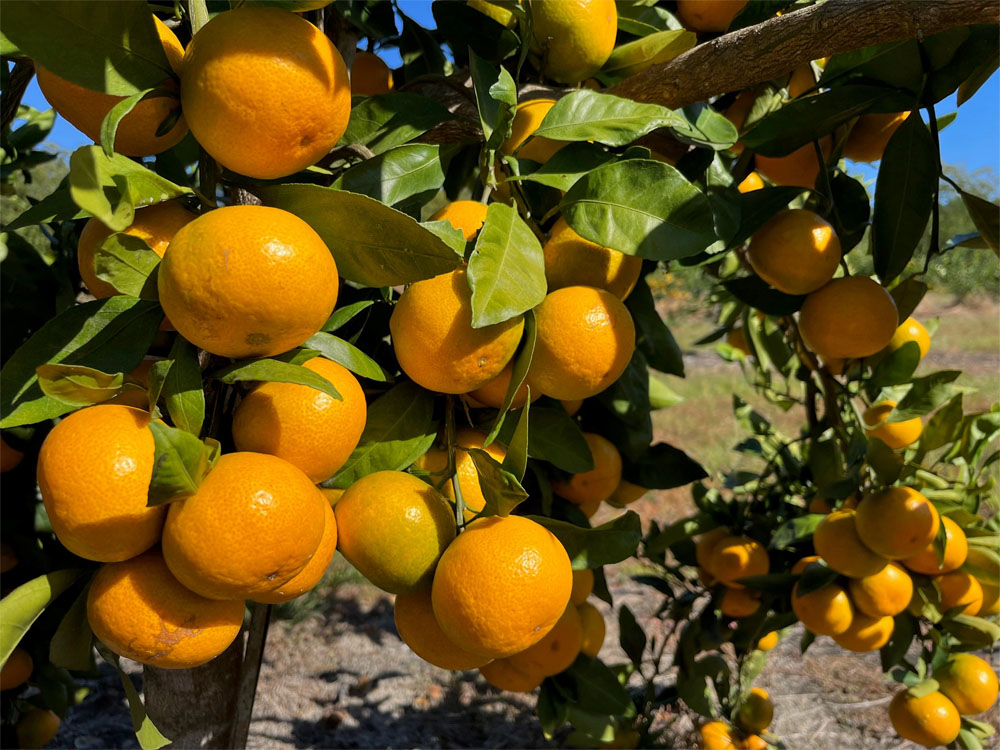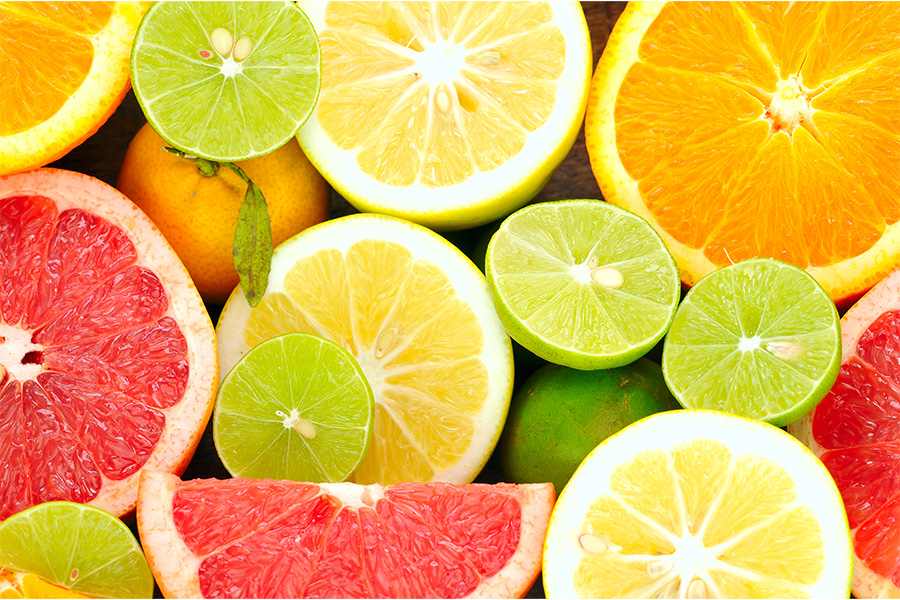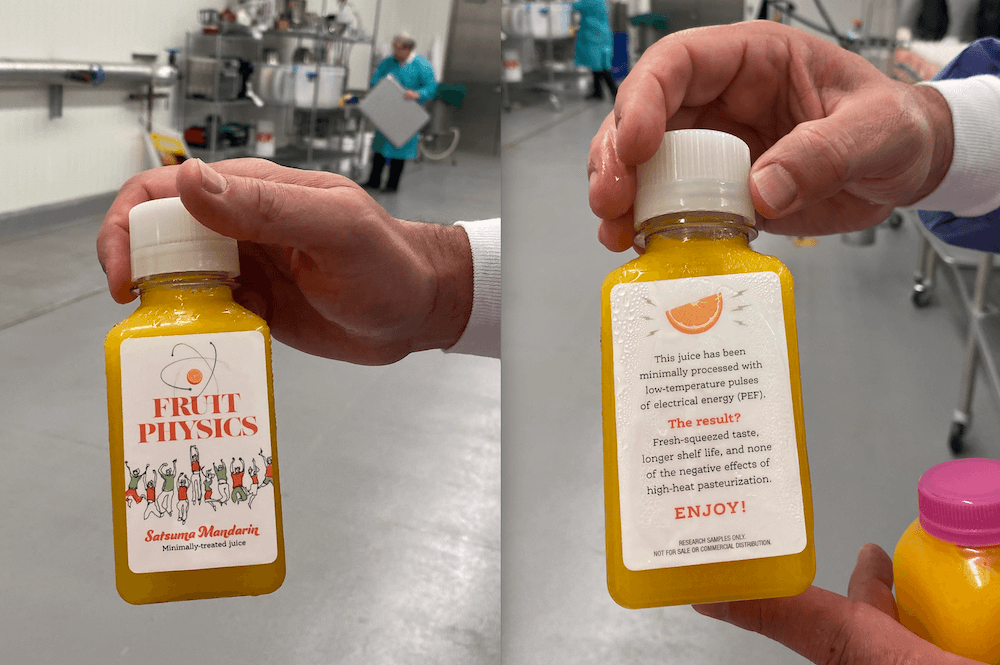Takeaways
- Freeze damage occurs when the water inside plant cells freezes.
- Citrus flowers are the tissues most susceptible to freeze damage, followed by vegetative flush, then fruit. Woody tissues are the least susceptible.
- Satsumas are the most cold-hardy, followed by mandarins, sweet oranges, grapefruit, then lemons and limes.
- Before a freeze event, protection can come from selecting an appropriate scion/rootstock combination, selecting a well-protected site, and implementing good cultural practices throughout the season.
- During a freeze event, active freeze protection methods provide protection by altering the microclimate around trees.
- If the graft union and a portion of the scion wood survive the freeze, the tree can likely recover.
The genus Citrus is native to the subtropical and tropical regions of southeast Asia. It has since spread worldwide, but commercial production has largely been limited to regions with milder temperatures. However, mounting disease and insect pressures, like the endemic nature of citrus greening and its vector in Florida, are steadily pushing citrus north.
The development of more cold-hardy citrus scions and rootstocks and improved freeze protection methods have allowed citrus production to move into regions that experience freezing temperatures during the winter months, such as in South Georgia. However, as citrus varieties grown in these regions are still susceptible to freeze injury, it is important to understand how freeze injury occurs and what steps can be taken to prevent it.
Types of Freezes
There are two types of freezes: advective and radiative. Advective freezes are characterized by wind bringing in an influx of cold, dry air that cools the environment. These conditions are usually seen as a cold front moves into the area.
Radiative freezes, on the other hand, are characterized by clear, calm, and cool conditions. These circumstances allow heat to escape from the surface of plants and the ground into the environment. The danger of radiative freezes lies in the duration of the freeze and the minimum temperatures reached. These radiative freezes generally follow advective freezes, and both types can cause damage to citrus trees (Smith et al., 2023).
To learn more about advective and radiative freezes, refer to UGA Cooperative Extension Bulletin 1479, Commercial Freeze Protection for Fruits and Vegetables.
Freeze Damage
Freeze damage occurs when the water within cells begins to freeze. This can happen in every tissue type (e.g., leaves, fruit, stems, trunks). Ice formation within the cell dehydrates the cell, causing death, similar to the dehydration that occurs during drought stress.
Water freezing in the cell also damages the cell wall and cell membrane, causing irreparable damage and disrupting their function (Yelenosky, 1996). This cellular damage is reflected in the water-soaked regions on leaf surfaces as they thaw. Freeze-damaged leaves can recover if the damage isn’t too severe. However, if substantial freeze damage occurs, leaves will become discolored once they thaw. Hardened-off leaves will turn brown (Figure 1A), while tender leaves will turn black. Severely damaged leaves will usually drop within a few days of thawing. If they do not drop, this can indicate the subtending wood was also severely damaged.
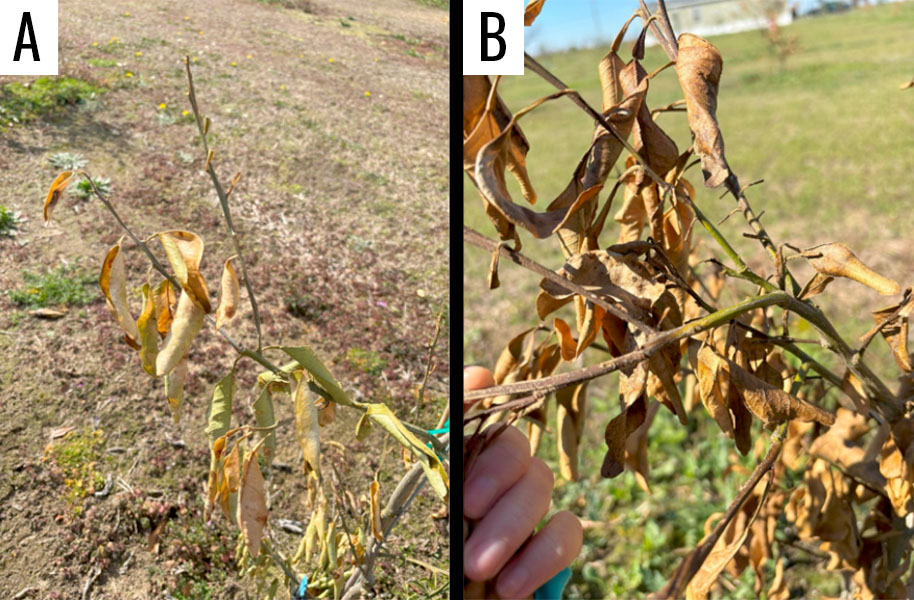
On any woody tissue, the degree of damage can be judged by scraping off the outer layer of bark to see if the wood is still alive (green) or dead (tan to brown; Figure 1B).
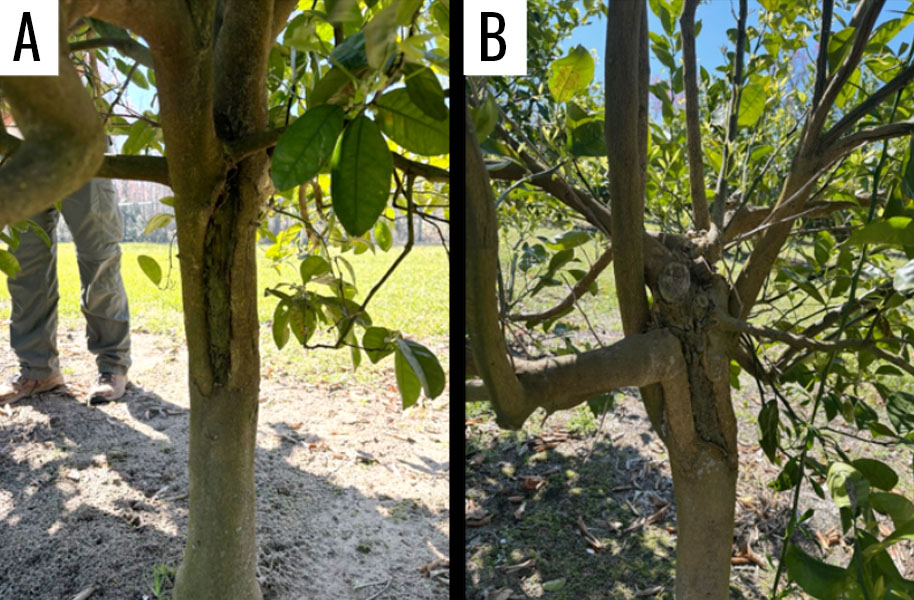
In addition to dieback, ice can also form in woody tissue, resulting in freeze cracks (Figure 2). These freeze cracks can occur in any woody tissue and can vary in size and depth depending on the severity of the freeze. Freeze cracks in the trunk and lower limbs can severely compromise the structural integrity and future production of a tree (Figure 2B).
Ice can also form in the fruit. After freezing, the juice vesicles in damaged fruit start to dry out and collapse, leaving the fruit unpalatable (Zekri et al., 2025).
Susceptibility
While all parts of a citrus tree are susceptible to freeze injury, they do differ in their degree of susceptibility. Flowers are generally the most susceptible tissue, followed by vegetative flush, then fruit, then hardened-off leaves, and the least susceptible are woody tissues (Oswalt & Kadyampakeni, 2020). Older, thicker woody tissue is less susceptible to freeze damage than younger, thinner wood.
Citrus varieties also vary in their cold-hardiness. Satsumas are the most cold-hardy of the commercial citrus types, followed by mandarins, sweet oranges, grapefruit, then lemon and limes (Figure 3).
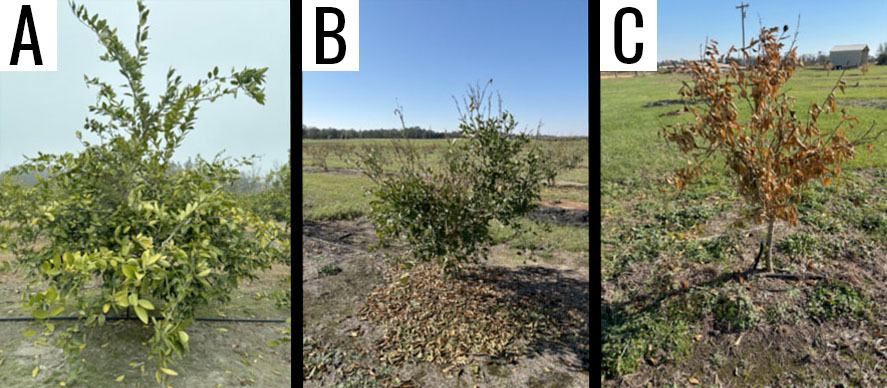
The rootstock contributes to the overall cold-hardiness of a tree. Generally, the more vigorous the rootstock, the more susceptible the tree will be to freeze damage (Oswalt & Vashisth, 2024). Most citrus trees in Georgia are grafted onto a trifoliate or trifoliate hybrid rootstock, as these tend to be cold-hardy. Refer to UGA Circular 1307, Factors that Influence Cold Hardiness of Citrus, for a more detailed discussion on cold-hardy citrus types grown in Georgia.
Acclimation
Generally, citrus is susceptible to freeze injury below 28 °F (~2.2 °C; Yelenosky, 1985). However, if trees are exposed to cooler weather (< 50 °F) for an extended period, they can survive drops below 28 °F. Cooler weather allows citrus trees to acclimate to colder temperatures and to enter a dormancy-like state called quiescence.
The acclimation process involves several internal changes that allow citrus trees to better tolerate drops in temperature. Namely, the amount of free water in cells decreases and the concentration of solutes (sugars) increases (Yelenosky, 1996; Oswalt & Kadyampakeni, 2020; Primo-Capella et al., 2021). This alters the cellular chemistry enough to lower the temperature at which water in plant cells will freeze.
It can take several weeks for these changes to occur and for trees to acclimate; thus, it is better to have continuous cool weather followed by a freeze event than to have warm weather followed by a sudden drop in temperature (Yelenosky, 1996; Oswalt & Kadyampakeni, 2020; Primo-Capella et al., 2021). This is the reason why early freezes (November or December) can cause more damage than later freezes (January or February). However, acclimation can be lost very quickly once temperatures rise, so spring frosts still pose a threat.
While acclimation can allow citrus trees to survive temperatures lower than 28 °F, that critical low temperature will vary throughout the season based on the following factors: the preceding air temperatures, the degree of acclimation obtained, the scion/rootstock combination used, the age of the tree, the health of the tree, and the current crop load.
Protection Methods
The degree of acclimation citrus trees obtain will ultimately determine how they will fare during a freeze event. However, there are several tools and practices growers and homeowners can use to protect their trees during a freeze event. Several practices can be adopted throughout the growing season to better prepare trees for the winter, and additional protection methods can be implemented during a freeze event. Both passive and active protection methods will increase the likelihood of a citrus tree surviving a freeze event.
Passive Methods
Passive freeze protection methods are those that are implemented throughout the growing season to prepare trees for winter. These methods, paired with active protection methods immediately prior to a freeze event, will provide the most protection for trees.
Scion/Rootstock Selection
Freeze protection should start at the conception of a new orchard. The average winter temperature in a given location will limit the types of citrus that can be planted there. Selecting an appropriately cold-hardy scion and rootstock combination for your location is the most critical decision made while planning a new site. The various freeze protection methods discussed here can only provide so much protection. For example, a freeze-protected grapefruit tree will sustain more damage than a similarly protected satsuma in the same location (Figure 3).
Likewise, the potential harvest window for a cultivar needs to be considered. All citrus fruits are susceptible to freeze damage, so harvesting before the first freeze of the winter is important (Oswalt & Vashisth, 2024). Early-maturing cultivars should be considered over later-maturing ones in regions where freezing is a concern.
Site Selection
Selecting the right location is also critical. Cold air accumulates in low areas if there is no outlet for the cold air to drain. Therefore, enclosed valleys or frost pockets should be avoided. If planting on a slope, the rows should run parallel to the slope to better facilitate air drainage through the field.
Planting on higher ground can also facilitate air drainage, but exposes trees to high winds during advective freezes. Planting near windbreaks (e.g., tall tree lines, buildings, etc.) can help reduce wind speeds and offer additional protection (Oswalt & Vashisth, 2024). However, if planting on a slope, a windbreak should not be at the base of the slope, as this will prevent the cold air from draining out of the field.
Each site will have its own strengths and weaknesses, and understanding them will help determine what active freeze protection methods should be used during the winter.
Cultural Practices
Good cultural practices throughout the season can help reduce a tree’s susceptibility to freeze damage. Ensuring adequate nutrition throughout the season reduces the chance of deficiencies arising during the winter. Trees that are nutrient-deficient are more susceptible to freeze injury (Lawless & Camp, 1940; Koo, 1985). Likewise, drought-stressed trees are more susceptible to injury, so good irrigation practices are important leading up to a freeze event.
Tall weeds in row middles can trap cold air in the rows instead of letting the air drain out of the field (Oswalt & Vashisth, 2024). These tall weeds also prevent the sun from adequately warming the soil during the day. Warmed soil can act as a heat reservoir on cold nights. Tall weeds beneath trees can also block irrigation emitters, reducing their efficacy as a freeze-protection method. Therefore, keeping row middles and the area under trees free of weeds and tall grass can reduce the chance of freeze injury.
Active Methods
There are several active freeze protection methods that can be implemented to protect citrus trees from freezing temperatures. These methods must be implemented BEFORE temperatures drop in order to be effective. All these methods work by keeping the temperature immediately around the tree a few degrees warmer than the surrounding air. Several of these methods are only effective under very specific weather conditions, so they should only be implemented as needed.
Microsprinkler Irrigation
Irrigation is the most common active protection method, but only offers protection if implemented properly. Protecting the graft union is critical; if the rootstock and some portion of the scion survive the freeze, the tree is more likely to recover (Figure 4).
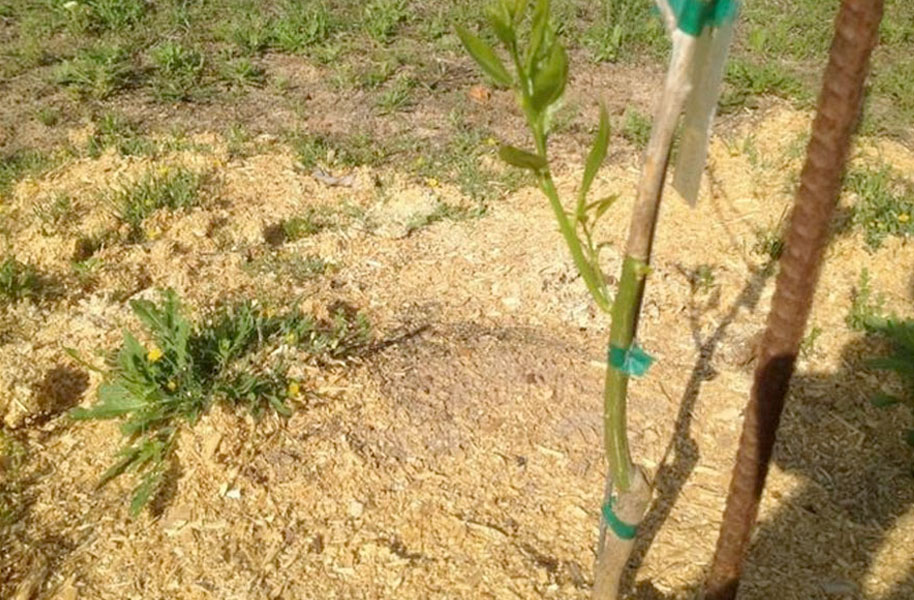
The goal of irrigation is to protect the graft union, ensuring the survival of the rootstock and a portion of the scion. To implement this, microsprinkler emitters of 90° to 180° should be placed within 12 in. of the trunk on the northwest side with the spray focused on the graft union (Figure 5).

Georgia cold fronts typically move in from the northwest, so the emitters should be on the side most likely to receive the incoming wind. In this way, the incoming wind will blow the irrigation water toward the tree rather than away from it.
Emitters can be elevated using PVC pipe to ensure water covers the graft union and provides protection to lower limbs. An emitter with a spray pattern of 90° to 180° is sufficient to protect the graft union of smaller trees. However, an emitter with a 270° to 360° spray pattern, elevated with PVC pipe, can provide protection to the graft union and lower limbs of larger trees. Protecting the rootstock, graft union, and lower limbs of the scion will increase the tree’s chance of survival.
Microsprinkler irrigation provides freeze protection in multiple ways. First, well water tends to be warmer than the air temperature, so the warmer water raises the temperature in the microclimate surrounding the tree. In some cases, this warmer water can also generate a fog, which slows the drop in temperature (Reiger, 1989). Second, as ice forms, it releases heat into the microclimate, which can raise the temperature within the irrigated zone a few degrees (Oswalt & Vashisth, 2024; Reiger, 1989). Third, ice formation on different plant tissues creates an igloo effect, insulating those tissues above critical temperatures (Oswalt & Vashisth, 2024). Limbs, leaves, and fruit outside the range of the irrigation will be more susceptible to freeze damage than those that fall within the range of irrigation. Therefore, in extended freezes, freeze injury can still be expected in the exterior parts of the canopy.
For irrigation to successfully protect trees, more water needs to be freezing than evaporating. Irrigation needs run at a rate of at least 10 gallons of water per tree per hour to adequately protect trees (Parsons, 2015; Parsons & Boman, 2022). Under windy conditions, the evaporation rate will be higher than under calm conditions, so a higher rate would be beneficial. Low irrigation rates (e.g., 1 to 2 gallons/hour/tree) will not provide adequate protection. The low rate can leave trees wet and vulnerable to freeze injury. Clear ice formation on the trunk and lower limbs indicates that irrigation is being applied at an adequate amount. The amount of water to be applied for a given low temperature can be found in Table 1 of Bulletin 1479, Commercial Freeze Protection for Fruits and Vegetables.
Drip and overhead irrigation do not provide the same level of protection as microsprinklers. While drip irrigation can still warm the soil and raise the surrounding temperatures a few degrees, it doesn’t provide coverage of the graft union or the lower limbs of the scion. Likewise, overhead irrigation does not provide consistent coverage of the graft union. Overhead irrigation can also lead to excessive ice formation on the upper and outer edges of the canopy, which increases the risk of limb breakage.
For irrigation to be an effective protection method, it needs to start before temperatures drop to freezing and continue to run for the entire duration of a freeze event. Ensure the emitters are not clogged before the need for freeze protection arises. Still water can freeze in the irrigation lines if temperatures drop to freezing before irrigation starts. Likewise, turning the irrigation off partway through a freeze event introduces another opportunity for the lines to freeze, and leaves the trees vulnerable as wet tissue is more susceptible to injury than dry tissue. For this reason, if irrigation is used for freeze protection, it is crucial that it runs continuously for the entire duration of the freeze event.
In summary, for irrigation to be an effective freeze-protection method, emitters should be oriented toward the graft union, irrigation should run at a rate of at least 10 gallons/hour/tree for the entire duration of the freeze event, and irrigation should be started before temperatures drop below freezing.
Trunk Wraps and Tree Covers
Various trunk wraps and tree covers can also be used to protect the graft union during freeze events (Figures 6A and 6B). Several wraps and covers are available on the market. Mounds of straw, bark, mulch, or soil have also been historically used to protect the trunk and graft union. However, having organic matter mounded around the graft union and scion significantly increases the incidence of disease and is therefore not recommended (Reiger, 1989).
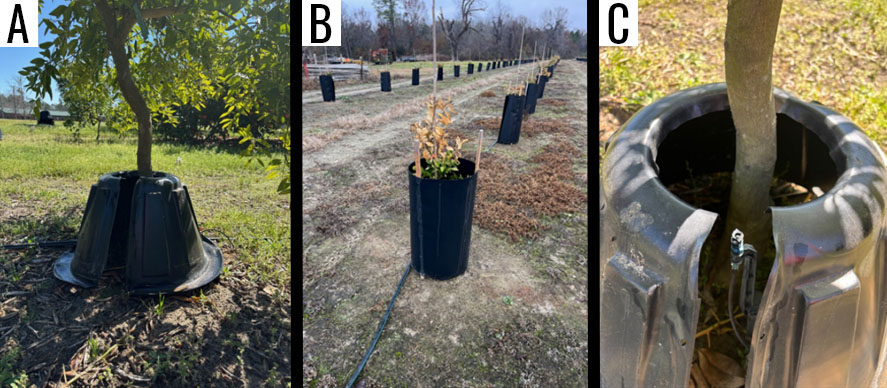
These wraps and covers work by slowing the drop in temperature around the tree, so they must be installed well in advance of any freezing temperatures (Oswalt & Vashisth, 2024). Both options only protect the area they cover (Figures 6A and 6B). Trunk wraps only protect the trunk, so the rest of the canopy is still susceptible to freeze injury.
Tree covers will also cover the canopy, but they can leave the trunk and graft union exposed to freeze injury if they do not extend to the ground and are not properly anchored to the ground. The trunks become less susceptible to freeze injury as trees age, so trunk covers are most effective in younger trees. For younger trees, additional protection can be achieved by pairing a trunk wrap with irrigation by placing the emitter inside the cover (Figure 6C).
Wind Machines
Wind machines can be used to reverse temperature inversions. Temperature inversions are characterized by a layer of warm air sitting above a layer of cold air. These typically only occur during radiative freezes. Wind machines push warmer air into the cold pocket. However, this method is only beneficial under very specific conditions (Smith et al., 2023). If there isn’t a temperature inversion, wind machines will not be as effective in displacing cold air. In fact, the increased air movement generated by the wind machine can promote evaporation and additional heat loss, increasing the likelihood of injury (Smith et al., 2023).
Heaters and Burn Piles
In the past, heaters or burn piles spaced throughout an orchard were used as an effective way of raising temperatures in the orchard. However, a lot of heaters or burn piles are needed per acre to keep temperatures above freezing. They need to burn for the entire duration of the freeze event to provide protection, so refueling is often necessary during the freeze event. Regular monitoring is therefore necessary to ensure the heaters and burn piles continue to burn, which exposes growers and their workers to adverse weather conditions. Implementing heaters and burn piles is no longer a regular practice because it is expensive and labor-intensive.
Recovery
Generally, if the graft union and some portion of the scion wood survive, freeze-damaged citrus trees can recover (Figure 4). More severe damage will require a longer recovery process. The full extent of freeze damage may not become evident for several months (Lawless, 1941; Zekri et al., 2025). Damaged leaves should drop on their own in the days following a freeze event, but woody tissue dieback can continue for several weeks. Early signs of recovery will become evident during the subsequent spring flush, so any cultural practices to support recovery should be delayed until then.
Do not prune immediately after a freeze event. If pruned too early, a follow-up pruning may be necessary to remove any missed dead wood. Pruning should be done to remove any dead wood. Pruning cuts should be made into live wood to ensure all dead wood is removed. Cutting into green wood also generates wounds that will be more susceptible to any freeze events that may occur later in the winter, so pruning is best done in late spring or early summer.
Freeze cracks in woody tissues are a concern for the future health of the tree. While shallower cracks may eventually heal over, larger ones may permanently damage a branch or trunk. Limbs with freeze cracks will be structurally weaker. Such limbs are more likely to break under heavy crop loads or other adverse weather conditions in the future.
As with pruning, fertilizing should be postponed until after the last frost date, as fertilizing too early can promote a vegetative flush that would be susceptible to late freezes. In freeze-damaged trees, severe canopy loss reduces transpiration and the water flow that is responsible for nutrient uptake. In such cases, excessive applications of nutrients can have a toxic effect and delay plant recovery. Therefore, fertilizer rates can be reduced in cases where severe canopy losses have occurred (Futch, 2020).
Following severe defoliation from a freeze event, a heavy vegetative flush can be expected in the spring. Extra care should be taken to control pests and diseases throughout the recovery period. The sparse canopy will also allow more sunlight to reach the ground beneath the trees, possibly allowing for more weed growth. Excessive weeds will compete with the recovering tree’s roots for nutrients and water.
A strict integrated pest management program should be followed to ensure a timely recovery of freeze-damaged citrus. Refer to UGA Bulletin 1520, Maintaining Commercial Citrus in Georgia, for more information on citrus pests and diseases.
References
Futch, S. H. (2020). Recovering from freeze damage (EDIS HS118). UF-IFAS Extension. https://doi.org/10.32473/edis-ch004-1992
Koo, R. C. J. (1985). Effects of nitrogen and potassium fertilization on winter injury of citrus trees. Proceedings of the Florida State Horticultural Society, 98, 53–56.
Lawless, W. W., & Camp, A. F. (1940). Preliminary reports on varieties, fertilizers, and other factors as influencing cold resistance in citrus. Proceedings of the Florida State Horticultural Society, 53, 120–125.
Lawless, W. W. (1941). Effect of freeze damage on citrus trees and fruit in relation to grove practices. Proceedings of the Florida State Horticultural Society, 54, 67–74.
Oswalt, W. C., & Kadyampakeni, D. M. (2020, November). Cold acclimation and freeze protection for Florida citrus. EDIS, 2020. https://journals.flvc.org/edis/article/view/124972
Oswalt, C., & Vashisth, T. (2024). 2024‑2025 Florida Citrus Production Guide: Citrus Cold Protection (CMG18). UF-IFAS Extension. https://doi.org/10.32473/edis-cg095-2023
Parsons, L. R. (2015). Microsprinkler irrigation for frost protection of citrus in Florida. Acta Horticulturae, 1065. https://doi.org/10.17660/ActaHortic.2015.1065.182
Parsons, L. R., & Boman, B. J. (2022). Microsprinkler irrigation for cold protection of Florida citrus (HS931). UF-IFAS Extension. https://doi.org/10.32473/edis-ch182-2003
Primo‑Capella, A., Martínez‑Cuenca, M. R., & Forner‑Giner, M. Á. (2021). Cold stress in citrus: A molecular, physiological and biochemical perspective. Horticulturae, 7(10), 340. https://doi.org/10.3390/horticulturae7100340
Reiger, M. (1989). Freeze protection for horticultural crops. In J. Janick (Ed.), Horticultural Reviews, 11 (pp. 45–109). Wiley. https://doi.org/10.1002/9781118060841.ch3
Smith, E., Coolong, T., & Knox, P. (2023). Commercial freeze protection for fruits and vegetables (Publication No. B 1479). UGA Cooperative Extension. https://fieldreport.caes.uga.edu/publications/B1479/
Yelenosky, G. (1985). Cold hardiness in citrus. In J. Janick (Ed.), Horticultural Reviews, 7 (pp. 201–238). Wiley. https://doi.org/10.1002/9781118060735.ch5
Yelenosky, G. (1996). An overview of Florida citrus freeze survival. Proceedings of the Florida State Horticultural Society, 109, 118–123.
Zekri, M., Oswalt, C., Futch, S., England, G., McAvoy, C., Hurner, L., & Platts, P. (2025). Freeze damage symptoms and recovery for citrus (Publication No. HS1275). UF-IFAS Extension. https://doi.org/10.32473/edis-hs1275-2016



